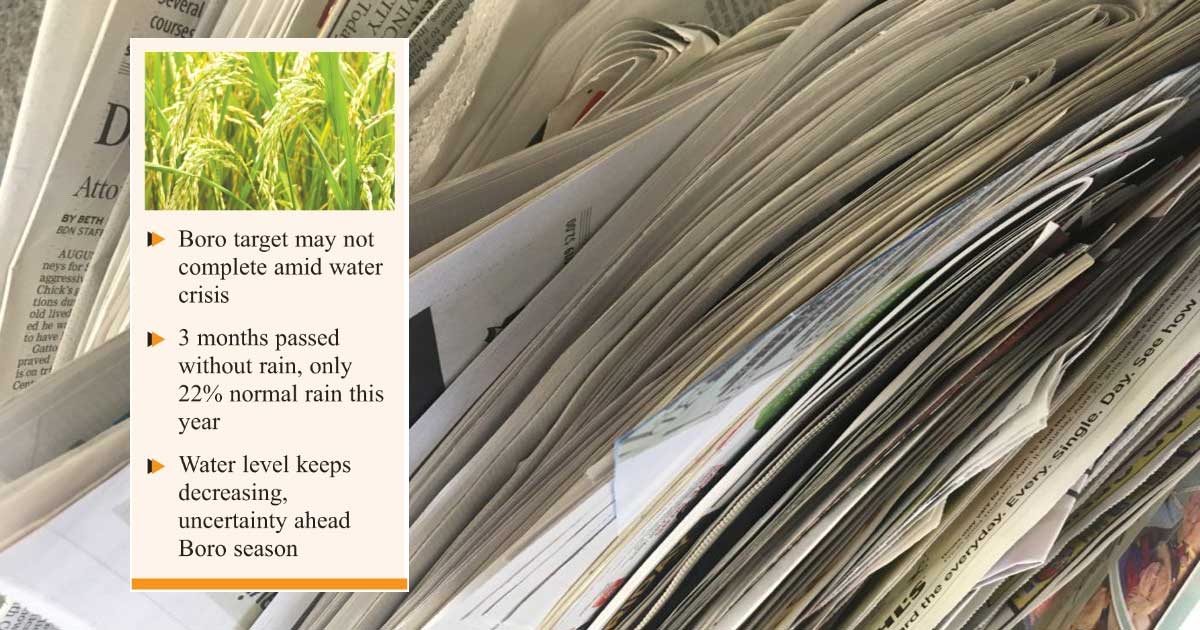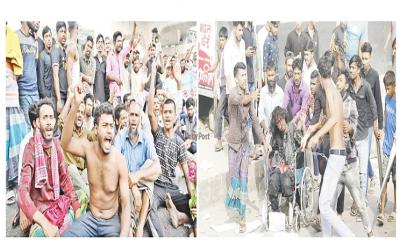# Boro target may not complete amid water crisis
# 3 months passed without rain, only 22% normal rain this year
# Water level keeps decreasing, uncertainty ahead Boro season
The agricultural sector of the country is affected by water crisis. Due to long absence of rain, the water sources are almost dry everywhere. The country's rivers, canals, rivers, ponds, ponds and drains have all dried up and stopped at the bottom. At the same time, the ground water level has also gone down by 8 to 10 feet in some places and 30 to 40 feet in some places. Due to the lack of minimum normal rainfall, the environment has become rough and dry. And agriculture and public health are being adversely affected. In the existing situation, the entire agricultural sector, starting from boro cultivation, seasonal fruits and crops, farms, fish farming, is in a state of extreme crisis. Boro plantation is being disrupted. Boro rice paddies are drying up. And the farmers are struggling to meet the shortage of water in agriculture to meet the additional cost of irrigation. This information is known from sources related to the Department of Agriculture. According to the relevant sources, there was not even a little rain anywhere in the country last January. And in November-December-January 3 consecutive months, 88 percent of normal rain did not fall in the country. That is, the last 3 months have passed without rain. It has been said in the weather forecast that less than normal rainfall i.e. drought may continue in the month of February and next March. In this situation, the draft can continue for at least 5 to 6 months. And due to the lack of rain for a long time, Boro plantations and other fruit crops have become dependent on irrigation. Groundwater is being extracted at an excessive rate due to the existing situation of surface water crisis. As a result, the groundwater level is going down. It is decreasing the surface and underground water reserves to an alarming extent. Due to lack of normal amount of rain during this season, water is not being recharged in above ground and underground sources. Drought risks are increasing as the water level goes down. As a result, the agricultural sector is facing a severe crisis. According to sources, water crisis is evident in Barendra region. Already the groundwater level has gone down a lot. 6 northern districts including Rajshahi are at high risk of drought. Although 22 districts of the country are at risk of drought, Rajshahi, Naogaon, Chapainawabganj, Jaipurhat, Dinajpur and Thakurgaon are at very high risk. Winters are short and droughts are prolonged due to random behavior of seasonal climate in Barendra region. The amount of rainfall has decreased. As a result, rain-fed crops have now become irrigated crops. Keeping in mind the food security, the cultivation is being carried out by taking water from the soil throughout the year. But due to insufficient rainfall, groundwater is not being recharged. As a result, the water level is falling. The situation is such that it has become difficult to reach water in many places. Prolonged drought is causing the most suffering in the region. Due to continuous lack of rain, even in the winter season, the water threat has become dire. As the boro plantation is being disrupted due to the lack of rain for a long time, the mango buds are falling due to the drought. Irrigation is also required in mango orchards now. And keeping food security in mind, more paddy is being cultivated in Barendra region. Other crops are also being cultivated. It increases the pressure on the groundwater. Sources also said that due to the lack of rain, all the canals and canals along with the rivers like Kartoa, Bengali, Ichamati, Nagar, Gang Nai etc. in Bougra have dried up. As a result, the main crop of this season is boro paddy and other crops including boro paddy seeds have become completely dependent on irrigation. It increases the production cost of crops. There is no end to the frustration of Sylhet farmers due to lack of sufficient irrigation water for boro cultivation. A large amount of uncultivated land has come under boro cultivation in Sylhet this season. But in the Haor region, because the fishing of the bill has ended, the water has dried up at the bottom. So the farmers are struggling with water irrigation in Boro paddy. Moreover, due to drying up of water in ponds, rivers and canals in the current dry season, uncertainty has arisen regarding the continuity of food supply in Cox's Bazar district. One of the canals supplying water to the cropland of the district has dried up. There is almost no water flow in the main rivers. The production of Boro and Ravishya on both banks of the main rivers Bankkhali and Matamuhuri has become precarious. Similarly, various canals flowing over Manikganj district have become waterless. Crop land is also affected. As there is no rain, the farmer has to irrigate with an alternative method of irrigation. The cost of agricultural production is increasing. Due to lack of rain, the field crops are drying up in different areas of Netrakona district. Farming is being disrupted. And in Barguna, a district in the southern part of the country, which is known as a grain farm, the cropland has burst into the ground due to the severity of the long continuous drought. Paddy seedlings and other crops have been burnt by the sun. Irrigation of cropland is being severely disrupted.
JH






